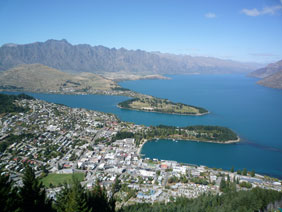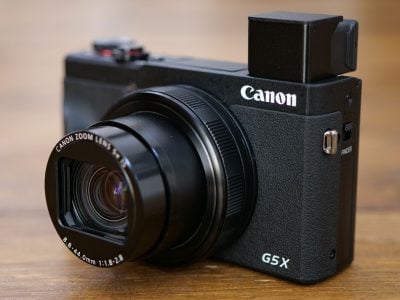Panasonic Lumix DMC-FX35
-
-
Written by Gordon Laing
Panasonic Lumix DMC-FX35 lens and stabilisation
The Panasonic Lumix DMC-FX35 is equipped with a new Leica DC Vario-Elmarit 4x optical zoom delivering an equivalent range of 25-100mm and a focal ratio of f2.8-5.6; the actual focal length is 4.4-17.6mm and we counted 20 discrete steps when zooming from wide angle to telephoto. The closest focusing distance is 5cm in Macro mode and the lens fully retracts into the body when powered down (or in play mode).
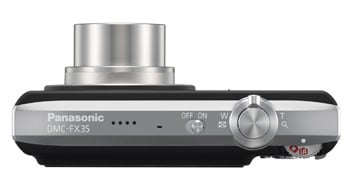 |
At a time when many compacts still have a widest equivalent coverage of 36 or 38mm, the 25mm of the new FX35 is particularly impressive – it even trumps the already respectable 28mm coverage of Panasonic’s other models. Indeed the FX35 now has one of the widest angle lenses you’ll find on a compact, and by also extending the 3.6x range of its predecessor to 4x, it offers the same 100mm telephoto when zoomed-in.
To illustrate the FX35’s 25-100mm coverage we mounted it on a tripod and shot the same scene fully zoomed-out, then fully zoomed-in. We then shot the same scene from exactly the same position moments later using the Fujifilm FinePix F30 which is equipped with a more typical 3x range equivalent to 36-108mm.
|
Panasonic Lumix FX35 coverage wide |
Fujifilm FinePix F30 coverage wide | |
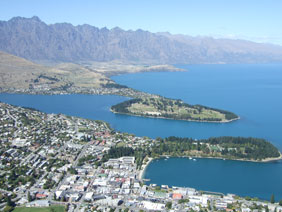 | ||
4.4-17.6mm at 4.4mm (25mm equivalent) |
8-24mm at 8mm (36mm equivalent) |
It’s immediately clear from the coverage examples above how the 25mm equivalent of the Panasonic FX35 can capture a considerably wider field of view than the 36mm of the Fujifilm. Indeed check out this same page from our Panasonic Lumix TZ5 review to see how much more it captures than a model with 28mm. As before, a wider angle lens is not just useful for big landscapes, but equally handy for capturing cramped interiors, large group shots or in situations when you just can’t step back any further.
The examples below taken with each camera fully zoomed-in show the F30 getting fractionally closer with its 108mm equivalent to the Panasonic’s 100mm, but there’s hardly anything in it. The FX35 has a far preferable range and we commend Panasonic for continuing to push the boundaries of wide angle coverage on compact cameras.
Panasonic Lumix FX35 coverage tele |
Fujifilm FinePix F30 coverage tele | |
 |  | |
4.4-17.6mm at 17.6mm (100mm equivalent) |
8-24mm at 24mm (108mm equivalent) |
Panasonic Lumix DMC-FX35 image stabilisation
The Panasonic Lumix FX35 features optical image stabilisation (OIS) which adjusts a lens to counteract for camera shake. Like other Panasonic models, the FX35 features two OIS modes: Mode 1 applies stabilisation constantly, while Mode 2 only applies the stabilisation as you take the picture. Mode 2 has the potential to be more effective since the system always starts from a central position, although you won’t see the effect as you compose the image. You can adjust the OIS mode from the Q.Menu or the main menu system. Note OIS is also available when recording movies, but only in Mode 1.
Panasonic Lumix DMC-FX35 Mega OIS off |
Panasonic Lumix DMC-FX35 Mega OIS Mode 1 |
Panasonic Lumix DMC-FX35 Mega OIS Mode 2 | ||
 |  |  | ||
| 4.4-17.6mm at 17.6mm, 1/13, 100 ISO | 4.4-17.6mm at 17.6mm, 1/13, 100 ISO | 4.4-17.6mm at 17.6mm, 1/13, 100 ISO |
Above are 100% crops taken from three examples taken with the FX35 zoomed-into its maximum 100mm equivalent focal length and at a shutter speed of 1/13: from left to right, with no stabilisation, with Mode 1 and then Mode 2. Traditional photographic advice would recommend a shutter speed of at least 1/100 to eliminate camera shake at this effective focal length so it’s not surprising to find the first example is blurred. It is however clear how the OIS modes have delivered a steadier image, and in dimmer conditions they can prove invaluable.
While the example here wasn’t pushing the system sufficiently hard to demonstrate the benefit of Mode 2 over Mode 1, we did find several situations where the extra stabilising effect of Mode 2 had an edge. As with other Panasonic compacts we’d recommend Mode 1 for general use as it delivers a steady image to compose with, but if it’s looking less than 100% sharp upon playback, try again in Mode 2. It may give you the extra boost you require under particularly demanding conditions.
Panasonic Lumix DMC-FX35 focusing
The Panasonic Lumix FX35 has the same AF modes of its predecessor: five main options along with support for face detection. The five main modes allow you to choose a balance between the number of focusing areas and the speed of operation – handy for times when you need quicker response, but from more predictable areas. Manual focusing is not available.
Like its predecessor, the FX35’s face detection can recognise and track up to 15 human subjects. In use it worked well under a variety of conditions and also locked-onto subjects even when they were almost in full profile. It’s activated automatically in the Portrait scene presets or when the Intelligent Auto mode spots a person. Alternatively you can manually select it from the Q.Menu or the main menu system when shooting in the Normal mode if desired.
Panasonic Lumix DMC-FX35 sensor and processing
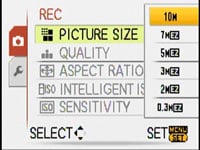 |
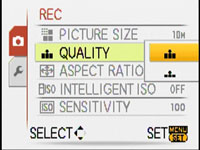 |
The Lumix FX35 is equipped with an 10.1 Megapixel CCD sensor, measuring 1 /2.33in. This gives the camera two extra Megapixels over its predecessor and generates 4:3 images with a maximum resolution of 3648×2736 pixels. There’s the choice of five lower resolutions, along with cropped 3:2 and 16:9 aspect ratio modes, each at four different resolutions.
The FX35 offers two JPEG compression options for each of these modes, although this adjustment has now moved from the FX33’s superimposed menu to the main menu system only on the FX35; no RAW mode is available. Best quality 10M JPEGs measure around 4.5MB each and there’s around 50MB of internal memory to get you started, along with a slot for SD or SDHC cards.
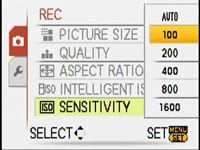 |
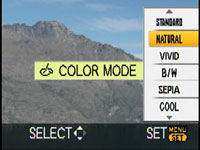 |
The sensitivity at full resolution runs from 100 to 1600 ISO (although Panasonic’s strange 1250 ISO option is now absent), while the High Sensitivity preset operates at 1600, 3200 or 6400 ISO depending on the conditions, albeit at a greatly reduced resolution of 3 Megapixels and with significant image processing. You can see samples using the complete range of full resolution sensitivities on our FX35 noise results page. The FX35 also offers five colour modes along with Black and White and Sepia options, and we used the default Standard mode for all our samples.
Panasonic Lumix DMC-FX35 movies
Video recording is a big feature for the Lumix FX35, as like the Lumix TZ5 it’s one of the first models to offer High Definition facilities. Panasonic has always been forward-thinking with its movie modes and long-offered 848×480 pixel widescreen recording when most others stuck with 4:3 aspect 640×480.
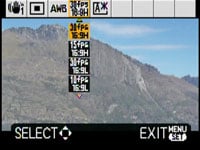 |
The new FX35 offers the same video options as the TZ5: these include the 848×480, 640×480 and 320×240 modes of the earlier FX33, all at either 30 or 10fps, but are now complemented with two new 16:9 HD modes which record 720p video at 1280×720 pixels in either 30 or 15 fps. Note, to access these or the 848×480 modes, you’ll need to first switch the FX35’s aspect ratio to 16:9. All video clips are saved in the Quicktime MOV format and sadly unlike the Lumix TZ5, you can’t optically zoom the lens while filming.
We filmed a variety of movies in the 30fps HD mode and played them back on both a PC monitor and a high definition projector. The quality was identical to those taken with the Lumix TZ5: as such, all were noticeably more detailed than clips filmed using the 848×480 pixel mode, but like all movie modes on still cameras, fell below what you’d enjoy with a dedicated camcorder. The HD video from the FX35 and the TZ5 can look quite noisy even under decent light, and the overall quality from a decent standard definition camcorder preferred, despite recording a smaller frame. The audio quality, like most still cameras, also remains pretty ropey.
That said, the HD modes are an improvement over the previous video options and another welcome feature to have on the FX35 – so long as you know it’s not a replacement for an HD camcorder, or even a decent SD model for serious work. As you might expect though, it’s fairly hungry on memory. With a data rate of around 25Mbit/s, you’re looking at approximately 3MB per second of HD footage at 30fps. You can keep filming until the file size reaches 2GB, giving you approximately 11 minutes of 30fps HD material.
Panasonic Lumix DMC-FX35 drive modes
The Panasonic Lumix FX35 offers a variety of continuous shooting options. First up are two burst modes available from the Q.Menu or the main menu system. The normal Burst mode can capture up to four or seven Fine or Standard quality JPEGs at a rate of 2.5 fps. With the FX35 set to Fine mode and equipped with a SanDisk Ultra II 1GB card though we only managed to capture three frames – like the Lumix TZ5 – although the rate was at least just below 2.5fps.
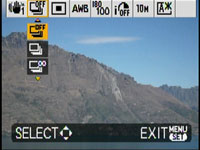 |
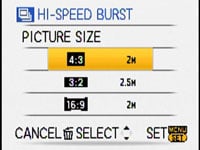 |
The Free Burst mode, labelled with an infinity symbol, lets you keep shooting while there’s free memory. Panasonic quotes a rate of around 2fps. Ours was slower, shooting 20 frames in 15.6 seconds and corresponding to rate closer to 1.3fps.
New to the FX35 over its predecessor is a High Speed Burst Scene preset which reduces the 4:3 resolution to 2 Megapixels, but allows you to shoot up to 100 images at 6fps; note the sensitivity runs between 500 and 800 ISO in this mode. We fired-off 100 shots in 16.9 seconds, corresponding to a rate of 5.9fps.
This mode may shoot at a reduced resolution, but the greatly increased frame rate and buffer means it’s possible to grab decent action sequences – something that’s not really possible with either of the standard burst modes.
